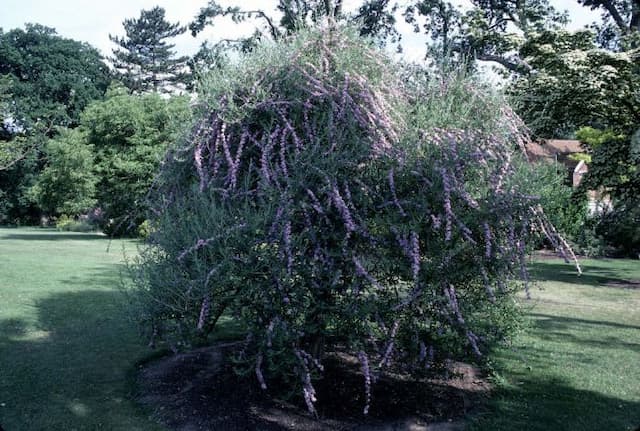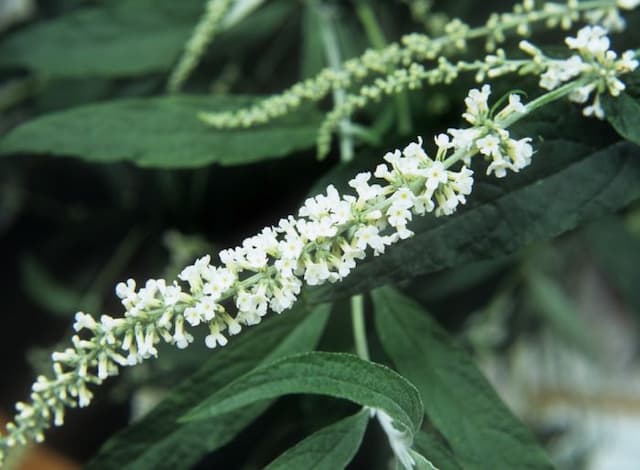Mullein Verbascum (Cotswold Group) 'Royal Highland'

ABOUT
Verbascum 'Royal Highland', commonly known as mullein, is a striking perennial with a rosette of large, fuzzy, silvery-green leaves that provide a textural contrast in the garden. The leaves are often broadly lance-shaped with a velvety texture that gives them a soft, inviting touch. During its bloom time, the mullein produces a dramatic display of flower spikes, which are adorned with individual blooms arranged in a dense, elongated cluster. The flowers of the 'Royal Highland' are particularly stunning, exhibiting a rich plum-purple color that can add both vertical interest and a bold splash of color to a planting scheme. This mullein variety is known for its showy appearance and can serve as an eye-catching focal point when in full bloom. The individual flowers are cup-shaped, with five rounded petals, and may be accented with delicate, stamen-like filaments that arise from their centers, contributing to their ornamental appeal.
About this plant
 Names
NamesFamily
Scrophulariaceae
Synonyms
Mullein, Velvet Plant
Common names
Verbascum (Cotswold Group) 'Royal Highland'.
 Toxicity
ToxicityTo humans
Mullein is generally not considered to be a toxic plant to humans. There are no well-documented reports of toxicity from ingesting mullein. However, as with any plant, individual allergies or sensitivities may exist, and it is always advisable to avoid eating plants that are not typically recognized as food sources due to potential adverse reactions.
To pets
Mullein is not listed as a toxic plant for pets, including cats and dogs. It is typically considered safe, and there should be no toxic effects if pets ingest parts of this plant. However, individual animals may have sensitivities or allergies, so it is always best to monitor your pet and ensure that they do not consume large quantities of any non-food plant material.
 Characteristics
CharacteristicsLife cycle
Biennials
Foliage type
Semi-deciduous
Color of leaves
Varies
Flower color
Yellow
Height
6 feet (1.8 meters)
Spread
2 feet (0.6 meters)
Plant type
Herb
Hardiness zones
5
Native area
Europe
Benefits
 General Benefits
General Benefits- Attracts Pollinators: The flowers of Verbascum 'Royal Highland' attract bees and butterflies, enhancing pollination in the garden.
- Ease of Growth: This plant is known for being easy to grow and can thrive in a range of soil types, including poor soils.
- Drought Tolerance: Once established, it has a good level of drought resistance, requiring less watering compared to other garden plants.
- Architectural Interest: With its tall spikes of flowers, Verbascum 'Royal Highland' provides vertical interest and structure to garden beds and borders.
- Long Blooming Period: It offers an extended flowering season from early to mid-summer, providing long-lasting color to the landscape.
- Low Maintenance: It generally requires minimal care beyond occasional watering and deadheading to promote continued blooming.
- Deer Resistance: Verbascum is not a favorite of deer, so it is less likely to be damaged by them in gardens where deer are a problem.
- Versatility: It can be used in various garden settings, including cottage gardens, rockeries, and as an accent plant in mixed borders.
 Medical Properties
Medical PropertiesThis plant is not used for medical purposes.
 Air-purifying Qualities
Air-purifying QualitiesThis plant is not specifically known for air purifying qualities.
 Other Uses
Other Uses- Lighting: The dried stalks of Mullein have a high resin content and were historically used as torches.
- Natural dye: Flowers of the Mullein plant can be used to produce a yellow or green dye for coloring wool or cloth.
- Toilet paper alternative: In historical or emergency situations, the large, soft leaves of Mullein have been used as a substitute for toilet paper.
- Fish sedative: In some cultures, Mullein seeds, which contain saponins, were historically used to stupefy fish, making them easier to catch.
- Shoe insulation: The leaves can be placed inside shoes to provide insulation and cushioning.
- Livestock feed: In some areas, Mullein is used as emergency fodder for livestock, particularly in times of drought.
- Insecticide: Mullein flowers steeped in oil can create an insecticidal spray for plants prone to insect damage.
- Frost protection: Mullein leaves can be used as a frost blanket for tender plants in the garden due to their thick, insulative nature.
- Fire starter: The fluffy seed heads of Mullein can catch a spark and are useful in starting a fire.
- Waterproofing: The waxy nature of Mullein leaves has been used to waterproof natural containers or as a covering to shed water.
Interesting Facts
 Feng Shui
Feng ShuiThe Mullein is not used in Feng Shui practice.
 Zodiac Sign Compitability
Zodiac Sign CompitabilityThe Mullein is not used in astrology practice.
 Plant Symbolism
Plant Symbolism- Healing: Verbascum, commonly known as Mullein, has been used for centuries in traditional medicine to treat respiratory ailments and skin conditions, symbolizing the plant's association with healing.
- Protection: Throughout history, Mullein has been carried as a talisman to ward off evil spirits and protect against misfortune, imbuing it with a strong symbolic meaning of protection.
- Consolation: The soft and velvety texture of Mullein leaves are often seen as comforting, providing a symbolic sense of consolation and empathy in times of distress.
- Purity: Mullein blossoms are bright and clear, commonly representing purity and virtue in various cultural contexts.
- Courage: With its tall and upright stature, Mullein stands as a symbol of courage and resilience, often encouraging individuals to stand strong in the face of adversity.
 Water
WaterMullein 'Royal Highland' needs regular watering but does not tolerate waterlogged soil, so it's crucial to allow the soil to dry out slightly between waterings. During active growth in spring and summer, water the plant approximately once a week with about one to two gallons, depending on weather conditions—less frequent water during cooler or rainy periods and more during hotter, drier weeks. Reduce watering in fall and significantly scale back during winter to prevent root rot, giving the plant just enough water to keep the soil from completely drying out, which could be as little as half a gallon every two weeks.
 Light
LightMullein 'Royal Highland' thrives best in full sun but can also tolerate partial shade. It should be placed in a spot where it receives at least six hours of sunlight a day to encourage strong growth and prolific blooming. Avoid deep shade as this can result in poor flowering and a leggy habit.
 Temperature
TemperatureIdeal temperature conditions for the Mullein 'Royal Highland' range from 50°F at night to 75°F during the day. It can survive minimum temperatures down to 20°F but should be protected from frost. The plant is not tolerant of extreme heat; prolonged exposure to temperatures over 85°F may stress the plant and impede growth.
 Pruning
PruningMullein 'Royal Highland' should be pruned to remove spent flower spikes and encourage a second flush of blooms. Deadheading throughout the blooming season will keep the plant looking tidy and promote more flowers. A more thorough pruning can be done in late fall or early spring, where you can cut back the foliage to create a compact shape and remove any damaged or dead material.
 Cleaning
CleaningAs needed
 Soil
SoilMullein (Verbascum) 'Royal Highland' prefers well-draining soil with a mixture of loam, peat, and coarse sand to enhance drainage. Aim for a soil pH ranging from 6.0 to 8.5 for optimal growth.
 Repotting
RepottingMulleins are biennial or short-lived perennials and do not typically require frequent repotting. Repot Mullein 'Royal Highland' only if it outgrows its current container, which may be once every 2-3 years.
 Humidity & Misting
Humidity & MistingMullein 'Royal Highland' is tolerant of a wide range of humidity conditions and does well in average atmospheric humidity levels; it does not have specific humidity requirements.
 Suitable locations
Suitable locationsIndoor
Place in bright light, minimal watering.
Outdoor
Full sun, well-drained soil, minimal care.
Hardiness zone
5-9 USDA
 Life cycle
Life cycleThe life cycle of Verbascum (Cotswold Group) 'Royal Highland', commonly known as the Cotswold King Mullein, begins with seed germination, which typically occurs in the spring or early summer. Upon sprouting, the seedlings develop into a rosette of leaves at the soil level during their first year, focusing energy on establishing a strong root system. In the second year, the plant sends up a tall flower spike that can reach several feet in height, with large, saucer-shaped flowers arranged along the stem that can vary in color from creamy white to yellow. After flowering, usually in mid to late summer, the plant sets seeds, which are dispersed by wind or wildlife, completing the reproductive cycle. Verbascum 'Royal Highland' is a biennial plant, meaning it typically completes its life cycle over two years, dying after seed production. While the parent plant dies, the new seeds ensure the continuation of the species, starting the cycle anew with the next generation of seedlings.
 Propogation
PropogationPropogation time
Spring-Early Summer
Verbascum, commonly known as mullein, is often propagated through seed sowing. The best time to sow mullein seeds is in late winter to early spring. The seeds of 'Royal Highland' can be sprinkled onto the surface of a well-draining seed starting mix, as they need light to germinate. The container should be placed in a warm area, around 65 to 70 degrees Fahrenheit (approximately 18 to 21 degrees Celsius), and kept moist. Seedlings usually emerge in 14 to 28 days. After the risk of frost has passed, the seedlings can be transplanted outdoors into their final position, ensuring they are spaced adequately to accommodate for their mature size.



![Butterfly bush [Florence]](/_next/image?url=https%3A%2F%2Fplants-admin.emdemapps.com%2Fimages%2Fplants%2F%2Fimages%2F604b5f52d7bb1.png&w=640&q=75)
![Butterfly bush [Marbled White]](/_next/image?url=https%3A%2F%2Fplants-admin.emdemapps.com%2Fimages%2Fplants%2F%2Fimages%2F604b63353832a.png&w=640&q=75)
![Butterfly bush [Nanho Blue]](/_next/image?url=https%3A%2F%2Fplants-admin.emdemapps.com%2Fimages%2Fplants%2F%2Fimages%2F604b55d0a6d2d.png&w=640&q=75)



